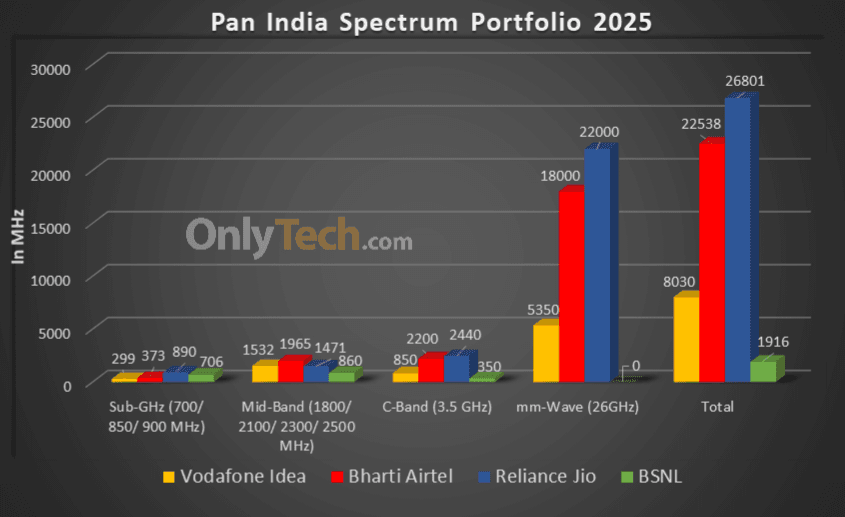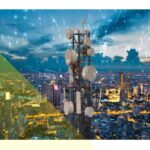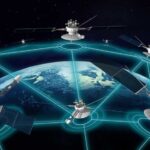Spectrum is for telecommunication what jet fuel is for aviation. Spectrum is a range of electromagnetic frequencies or airwaves that telecom companies use for establishing a connection between a cell tower and a mobile phone. The bandwidth of this spectrum is directly proportional to the speed of a wireless data network (since more data can be transmitted simultaneously through a broader data pipeline). In contrast, the frequency is inversely proportional to the coverage (since lower frequencies penetrate better through physical barriers and thus have wider coverage).
The spectrum holding data sheet embedded in this article represents the current spectrum holdings of all active telecom operators across all frequency bands across all 22 telecom circles along with their liberalisation status and expiry dates. All figures represented are in MHz. The value mentioned in the bracket beside the frequency at the base of each sheet is the band number where ‘B’ stands for 4G LTE band whereas ‘n’ stands for the corresponding 5G NR band.
The spectrum shown under BSNL and Aircel in white is reserved for the respective operators but has not yet been officially allotted to them.
Spectrum Liberalisation:
Spectrum was administratively allocated to operators in each of the 22 licensed service areas or circles prior to 2010, this spectrum is called non-liberalised and can only be used for 2G services whereas all airwaves allotted post-2010 have been through a Spectrum Auction where operators have paid the market discovered price and this spectrum is called liberalised and can be used for any technology platform 2G/3G/4G/5G. Alternatively, operators may choose to liberalise their administratively allotted spectrum by paying the market-discovered price to DoT on a pro-rata basis for the remaining validity of the spectrum.
Paired and Unpaired spectrum:
Spectrum may be paired or unpaired, bands 1/3/5/8/28 are all paired where one set of frequencies is used for uplink whereas another distinct set of frequencies is used for downlink known as Frequency-division duplexing (FDD), whereas bands 40/41/78/258 are unpaired where both uplink and downlink happens in the same set of frequencies separated by the time of uplink and downlink known as Time-division duplexing (TDD).
List of Indian FDD Bands:
| 4G LTE band | 5G NR band | Uplink frequency range (MHz) | Downlink frequency range (MHz) | Bandwidth for telecom (MHz) | Block size (MHz) |
|---|---|---|---|---|---|
| B1 | n1 | 1939-1979 | 2129-2169 | 40×2 | 5×2 |
| B3 | n3 | 1710-1780 | 1805-1875 | 70×2 | 0.2×2 |
| B5 | n5 | 824-844 | 869-889 | 20×2 | 1.25×2 |
| B8 | n8 | 890-915 | 935-960 | 25×2 | 0.2×2 |
| B28 | n28 | 723-733/ 738-748 | 778-788/ 793-803 | 20×2 | 5×2 |
List of Indian TDD Bands:
| 4G LTE band | 5G NR band | Frequency range (MHz) | Bandwidth for telecom (MHz) | Block size (MHz) |
|---|---|---|---|---|
| B40 | n40 | 2300-2380 | 80 | 10 |
| B41 | n41 | 2535-2555/ 2615-2655 | 60 | 10 |
| – | n78 | 3300-3670 | 370 | 10 |
| – | n258 | 24250-27500 | 3250 | 50 |
Spectrum caps:
A spectrum cap dictates how much spectrum a particular operator can hold in a circle for a specific band. There is a 40% cap for Sub-GHz spectrum in the 700/850/900 MHz bands combined, a 40% cap for Mid-Band spectrum in the 1800/2100/2300/2500 MHz bands combined, a 40% cap for the C-Band spectrum of 3300-3670 MHz and a 40% cap for the mm-Wave spectrum bands of 24.25-27.5 GHz. The current spectrum caps are denoted in the spectrum chart.
Overall spectrum holdings of operators (in MHz):
| Operator/Holding | Jio | Airtel | Vi | BSNL |
|---|---|---|---|---|
| Sub-GHz | 890 | 373.2 | 298.8 | 706 |
| Mid Band | 1470.8 | 1964.9 | 1531.6 | 860 |
| C-Band | 2440 | 2200 | 850 | 350 |
| mm-Wave Band | 22000 | 18000 | 5350 | 0 |
| Total | 26,800.8 | 22,538.1 | 8,030.4 | 1,916 |
Spectrum sharing/trading/leasing guidelines:
- Telecom operators holding CMTS/UASL/UL licenses can enter into a Spectrum-Sharing agreement with each other so long as both parties hold liberalised spectrum in the same band in the same circle. Spectrum sharing is possible only on a Pan LSA level in block sizes defined by DoT and only after one year of an operator acquiring the spectrum.
- Telecom operators holding CMTS/UASL/UL licenses can enter into a Spectrum-Trading agreement with each other so long as the spectrum being sold is liberalised. Trading of spectrum is possible only on a Pan LSA level in block sizes defined by DoT and only after two years of an operator acquiring the spectrum.
- Telecom operators may enter into a Spectrum-Leasing agreement only with Enterprises holding a Captive Non-Public Network (CNPN) license and not with each other. The lease may be limited to any geographic area within the LSA and for any duration mutually agreed upon by both parties. A CNPN licensee can lease spectrum from multiple operators within an LSA.
Note: We update this chart in real-time to ensure it is always up to date with the latest changes in spectrum holding. Certain human errors might have crept in during the manual compilation of the data, any mistakes/ rectification can be brought to the Team’s notice through the comments section below.








@Esmail: Also what about Jio 850 band (B5) allocation for UP (West) circle ? Would the last carrier be 1.25 mhz or 0.75 mhz ? If it is 0.75 mhz then is it possible that DOT reshuffles all the spectrum holdings in this band in UP (West) circle and allocates the last carrier of 0.75 mhz to RCOM since they are not actually utilizing that spectrum in UP (West) circle ? Also does Jio have any spectrum sharing agreement for Band 5 in UP (West) circle with RCOM right now.
The last carrier initially will be 0.75 MHz and even though in the provisional results it shows the downlink for last block to be 885.25-886.5 it will get reshuffled post harmonisation and become 887.75-888.5 and get converted to 889 after DoT runs the field trials to check for interference with the uplink portion of 900 MHz band. Also as far as Rcom is concerned, even though the network is not being used for commercial services for end users like you and me, the network is still live and apparently available for enterprise users, Rcom still reports it’s subscriber numbers to TRAI every month. And no Jio doesn’t have any active spectrum sharing agreement with Rcom in UP West, now such an agreement exists only for Assam and North East circles.
@Esmail: Can’t DOT allocate that 0.75 carrier to RCOM and give full 10 mhz to Jio in UP (West) circle after reshuffling ?
No that isn’t possible in UP west circle. That consideration can be done in J&K circle in 2024 when 2.5 MHz of Rcom expire and then DoT can swap one of Jio’s carrier with that but not while the spectrum is still held by Rcom. But I have a feeling that the field trials will show no interference with 900 MHz band and Dot will convert it to 1.25 MHz in a few months.
@Esmail: Bro There are hardly any phones in the market which support 5G Carrier Aggregation. Then why did Jio go for 130 mhz in N78 band for 8 circles. Also if a device does not support 5G Carrier Aggregation, then a user who is connected to 30 mhz N78 carrier will get lower speed than the 100 mhz N78 carrier. Isn’t it ?
Yes if the phone doesn’t support Carrier aggregation then the person connected to the 30 MHz block will get lower speed compared to the one connected to the 100 MHz block, unless there are way more users connected to the 100 MHz block increasing the contention ratio and dividing the the bandwidth among them and only a handful of users connected to the 30 MHz block and thus higher bandwidth available to each individual user.